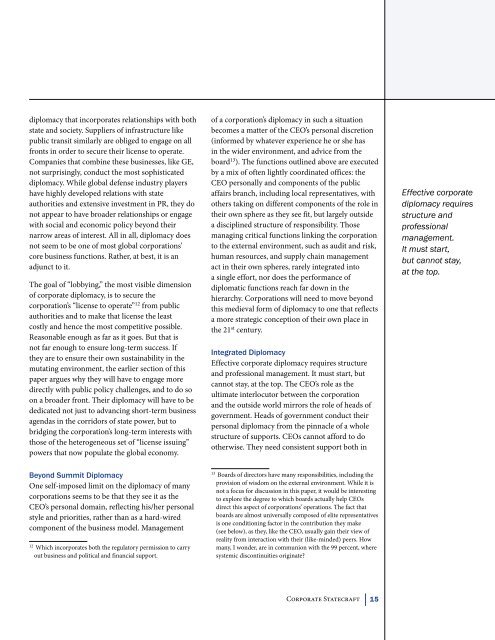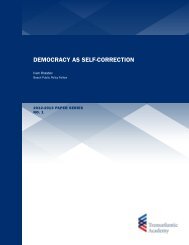CORPORATE STATECRAFT - Transatlantic Academy
CORPORATE STATECRAFT - Transatlantic Academy
CORPORATE STATECRAFT - Transatlantic Academy
Create successful ePaper yourself
Turn your PDF publications into a flip-book with our unique Google optimized e-Paper software.
diplomacy that incorporates relationships with bothstate and society. Suppliers of infrastructure likepublic transit similarly are obliged to engage on allfronts in order to secure their license to operate.Companies that combine these businesses, like GE,not surprisingly, conduct the most sophisticateddiplomacy. While global defense industry playershave highly developed relations with stateauthorities and extensive investment in PR, they donot appear to have broader relationships or engagewith social and economic policy beyond theirnarrow areas of interest. All in all, diplomacy doesnot seem to be one of most global corporations’core business functions. Rather, at best, it is anadjunct to it.The goal of “lobbying,” the most visible dimensionof corporate diplomacy, is to secure thecorporation’s “license to operate” 12 from publicauthorities and to make that license the leastcostly and hence the most competitive possible.Reasonable enough as far as it goes. But that isnot far enough to ensure long-term success. Ifthey are to ensure their own sustainability in themutating environment, the earlier section of thispaper argues why they will have to engage moredirectly with public policy challenges, and to do soon a broader front. Their diplomacy will have to bededicated not just to advancing short-term businessagendas in the corridors of state power, but tobridging the corporation’s long-term interests withthose of the heterogeneous set of “license issuing”powers that now populate the global economy.of a corporation’s diplomacy in such a situationbecomes a matter of the CEO’s personal discretion(informed by whatever experience he or she hasin the wider environment, and advice from theboard 13 ). The functions outlined above are executedby a mix of often lightly coordinated offices: theCEO personally and components of the publicaffairs branch, including local representatives, withothers taking on different components of the role intheir own sphere as they see fit, but largely outsidea disciplined structure of responsibility. Thosemanaging critical functions linking the corporationto the external environment, such as audit and risk,human resources, and supply chain managementact in their own spheres, rarely integrated intoa single effort, nor does the performance ofdiplomatic functions reach far down in thehierarchy. Corporations will need to move beyondthis medieval form of diplomacy to one that reflectsa more strategic conception of their own place inthe 21 st century.Integrated DiplomacyEffective corporate diplomacy requires structureand professional management. It must start, butcannot stay, at the top. The CEO’s role as theultimate interlocutor between the corporationand the outside world mirrors the role of heads ofgovernment. Heads of government conduct theirpersonal diplomacy from the pinnacle of a wholestructure of supports. CEOs cannot afford to dootherwise. They need consistent support both inEffective corporatediplomacy requiresstructure andprofessionalmanagement.It must start,but cannot stay,at the top.Beyond Summit DiplomacyOne self-imposed limit on the diplomacy of manycorporations seems to be that they see it as theCEO’s personal domain, reflecting his/her personalstyle and priorities, rather than as a hard-wiredcomponent of the business model. Management12Which incorporates both the regulatory permission to carryout business and political and financial support.13 Boards of directors have many responsibilities, including theprovision of wisdom on the external environment. While it isnot a focus for discussion in this paper, it would be interestingto explore the degree to which boards actually help CEOsdirect this aspect of corporations’ operations. The fact thatboards are almost universally composed of elite representativesis one conditioning factor in the contribution they make(see below), as they, like the CEO, usually gain their view ofreality from interaction with their (like-minded) peers. Howmany, I wonder, are in communion with the 99 percent, wheresystemic discontinuities originate?Corporate Statecraft 15









